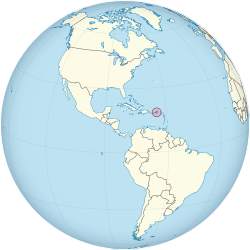
Back الهند الغربية الدنماركية Arabic Indies Occidentales Daneses AST Danimarka Qərbi Hindistanı Azerbaijani Дацкая Вест-Індыя Byelorussian Дацкая Вэст-Індыя BE-X-OLD Inizi Gwerc'h Danat Breton Dánská Západní Indie Czech Dansk Vestindien Danish Dänisch-Westindien German Danaj Okcidentaj Indioj Esperanto
You can help expand this article with text translated from the corresponding article in Danish. (September 2020) Click [show] for important translation instructions.
|
Danish West Indies Dansk Vestindien | |||||||
|---|---|---|---|---|---|---|---|
| 1672–1917 | |||||||
|
The Flag of Denmark | |||||||
 | |||||||
| Status | Colony of Denmark–Norway (1672–1814) Colony of Denmark | ||||||
| Capital | Charlotte Amalie (1672–1754,1871–1917) Christiansted (1754–1871) | ||||||
| Common languages | Danish English English Creole Dutch Dutch Creole | ||||||
| Governor-General | |||||||
• 1756–66 | Christian Leberecht von Prøck (first) | ||||||
• 1916–17 | Henri Konow (last) | ||||||
| History | |||||||
• Danish West India Company takes possession of Saint Thomas | 1672 | ||||||
| 1685–1754 | |||||||
• Saint John colonized and claimed | 1717–1718 | ||||||
• Danish West India Company purchases Saint Croix from French West India Company | 1733 | ||||||
| 31 March 1917 | |||||||
| Area | |||||||
| [1] | 400 km2 (150 sq mi) | ||||||
| Population | |||||||
• 1911[1] | 27,000 | ||||||
| Currency | Rigsdaler (1754–1849) Daler (1849–1917) From 1905, the currency of the Latin Coin Union was used Danish krone-DKK (1875-1917) | ||||||
| |||||||

| History of the United States Virgin Islands |
|---|
 |
|
|
The Danish West Indies (Danish: Dansk Vestindien) or Danish Virgin Islands (Danish: Danske Jomfruøer) or Danish Antilles were a Danish colony in the Caribbean, consisting of the islands of Saint Thomas with 32 square miles (83 km2); Saint John (Danish: St. Jan) with 19 square miles (49 km2); and Saint Croix with 84 square miles (220 km2). The islands have belonged to the United States as the Virgin Islands since they were purchased in 1917. Water Island was part of the Danish West Indies until 1905, when the Danish state sold it to the East Asiatic Company, a private shipping company.
The Danish West India-Guinea Company annexed uninhabited St. Thomas[2] in 1672; annexed St. John in 1718; and bought St. Croix from France (King Louis XV) on June 28, 1733. When the Danish West India-Guinea Company went bankrupt in 1754, King Frederik V of Denmark–Norway assumed direct control of the three islands. Britain occupied the Danish West Indies in 1801–1802 and 1807–1815 during the Napoleonic Wars.
Danish colonizers in the West Indies aimed to exploit the profitable triangular trade, involving the export of firearms and other manufactured goods to Africa in exchange for slaves, who were then transported to the Caribbean to work the sugar plantations. Caribbean colonies, in turn, exported sugar, rum and molasses to Denmark. The economy of the Danish West Indies depended on slavery. After a rebellion, slavery was officially abolished in 1848, leading to the near economic collapse of the plantations.
In 1852, the Danish parliament first debated the sale of the increasingly unprofitable colony. Denmark tried several times to sell or exchange the Danish West Indies in the late 19th and early 20th centuries: to the United States and to the German Empire, respectively. The islands were eventually sold to the United States for $25 million (equivalent to $594,550,000 in 2023) which took over the administration on 31 March 1917 and renamed the territory the United States Virgin Islands.
- ^ a b "Dansk Vestindia". Caplex. Retrieved 21 May 2010.
- ^
Dookhan, Isaac (1994) [1974]. "Danish Colonial Expansion". A History of the Virgin Islands of the United States. Kingston, Jamaica: Canoe Press. p. 40. ISBN 9789768125057. Retrieved 7 September 2017.
The Danes found no one living on St. Thomas when they landed. The English settlers who had occupied the island after the end of the first Danish settlement, had left six or seven weeks before, though the reason for their departure is not known. [...] Denmark's long association with the Virgin Islands began with this occupation of St. Thomas in 1672.
© MMXXIII Rich X Search. We shall prevail. All rights reserved. Rich X Search
